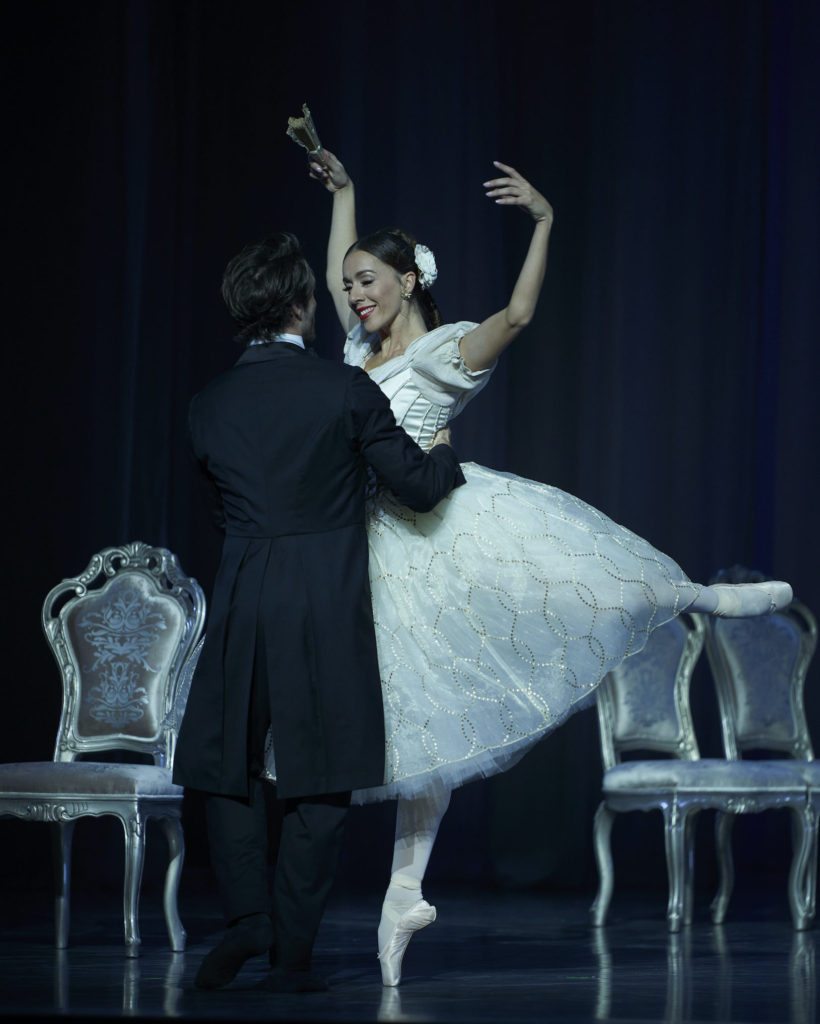La Dame aux Camélias: Peter Quanz’s new and beautiful ballet - Vancouver Ballet Society
- Home
- Reviews 2020 - 2023
- La Dame aux Camélias: Peter Quanz’s new and beautiful ballet

By Gary Smith
There sometimes comes a moment in a choreographer’s career where inspiration, imagination, and dramaturgy ally in a very special way. As an audience member, there are sometimes moments when movement becomes more than steps, more than storytelling, when something happens onstage that lifts you out of your theatre seat and into the heart and soul of a passionate narrative.
These very things happened opening night at Place Ville Marie in Montreal, when Les Grands Ballets Canadiens premiered Peter Quanz’s stunning La Dame aux Camélias, running October 19-28. Quanz has taken Alexandre Dumas fils’ tale of doomed lovers Marguerite and Armand, creating from their troubled romance a world that penetrates surface notions of love, lust, regret, and tragedy. He plunges us into the heart of the demimonde of mid-19th-century France. He has done it with a letter sent by the desperate courtesan, Marguerite Gautier, to her beloved Armand and through a prologue he has distilled from the novel itself.

Words in fact are everywhere in this deeply felt ballet, which begins with writing scrawled black on white across the filmy house curtain. A narrator speaks them in French, while the performers dance their meaning in a most contemporary way. And then, in the ballet’s final devastating moments, there is a coup de théâtre, a glorious moment of theatre and dance as letters drift languidly down from high up in the theatre’s fly gallery. The three dancers who portray Marguerite disappear into whirling circles of corps de ballet members, never to be seen again, never to be used by men, used up by the world.
Such moments of high theatre are everywhere in this ballet, which is both big and small in its dramatic landscape. Big because it suggests a world where women are objects of desire, seldom treated as more than glamorous playthings. Small because it focuses tightly on Marguerite and her Armand, who ultimately is revealed here as a male user who takes far more than he gives.
In offering three Marguerites, paired by three Armands, Quanz explores facets of the title character at various key moments in their relationship. The three captivating, dramatically astute ballerinas who play Marguerite do not look the same, yet they seem to take on the same appearance, the same heartbreak.

The choreography is powerful, yet exquisite. It is classical, or perhaps more correctly neo-classical, as you might expect if you know Quanz’s love of ballet. But it has a contemporary feel, particularly through the simple physical trappings that help to create its intimate world.
Michael Gianfrancesco’s evocative set, a world of sheer, frequently rising and descending curtains, is washed over by Marc Parent’s painterly lighting that ranges from a cold cobalt grey to a pristine orange. Perfectly chosen furnishings are whisked on and off the stage by the dancers. There is never anything weighty to disturb the ballet’s sense of flow. Anne Armit’s costumes for the women, with their flirty crinoline layers, move with breathtaking whispers of romance and sex.
Graceful, sometimes passionate lifts, along with whirling steps, whiplash turns, delirious backbends, and tiny hopping steps on pointe, suggest a world of impassioned love and sexual adventure that seeks release in desperate abandonment. A lyric luminescence keeps this La Dame aux Camélias in perpetual and frequently surprising motion.
There have, of course, been superb balletic versions of Dumas’ novel. Frederick Ashton’s Marguerite and Armand, a 33-minute ballet created expressly for Fonteyn and Nureyev in 1963 for London’s Royal Ballet, wasn’t pure narrative either, but rather “a tabloid,” as its creator called it. It relied heavily on two star performers dancing to the music of Liszt, and bears little relation to Quanz’s more expansive story. John Neumeier’s gorgeous Die Kameliendame, created in 1978 for Stuttgart Ballet, is a more narrative telling of the story, replete with lavish sets and costumes, and blessed with music by Chopin.

Quanz has chosen more metaphysical imagery and less linear storytelling than either of these famous productions. He breaks the piece into sections: first, L’Amour, which shows the journey of the two lovers, danced by the ravishing Rachele Buriassi and supportive Esnel Ramos.
Part two, Le Sacrifice, is danced by the second set of lead characters, a less flamboyant, but equally mesmerizing Maude Sabourin, partnered by Raphaël Bouchard, transitioning from bucolic bliss to exploitation. L’Abîme follows, in which a passionate Anya Nesvitaylo and a devastated Roddy Doble explore exclusion from society and notions of mortality. Finally, there is Le Trépas, where all three Marguerites coalesce onstage, transcending earthly bonds.
Music for the production, sourced by Quanz and arranged by Florian Zieman, is performed live, sometimes on solo piano, played ravishingly by Rosalie Asselin, and sometimes by a 43-piece orchestra in full throttle, conducted with superb control by Dina Gilbert. The music comes from primarily female composers: Lili Boulanger, Louise Farrenc, Fanny Mendelssohn, Kaija Saariaho, and Clara Schumann.
Quanz has been working for China’s Harbin Ballet for a number of years, where he is revered for his creative instincts, and these days seldom works at home in Canada. After this thoughtful, dramatically rich production of La Dame aux Camélias for Les Grands Ballets Canadiens, let’s hope he creates many more for other Canadian ballet stages.

